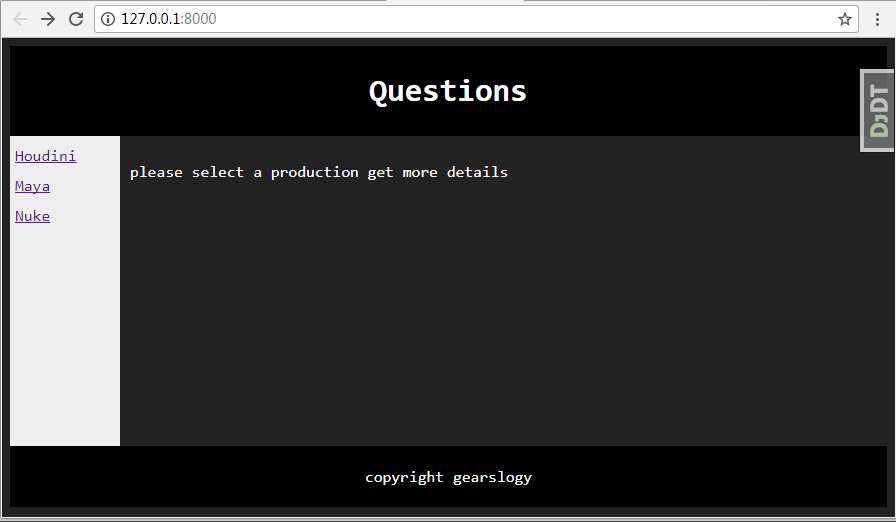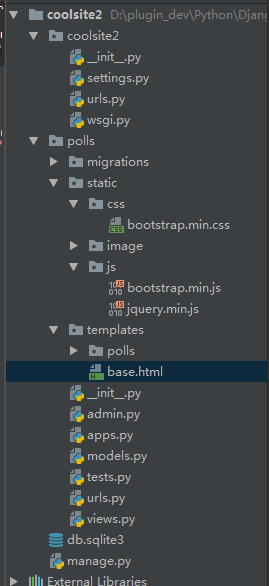Web从入门到放弃<2>
<添加debug-toolbar>
django现在1.11是必须这么做:
pip install django-debug-toolbar
设置1:
INSTALLED_APPS = [ 'django.contrib.admin', 'django.contrib.auth', 'django.contrib.contenttypes', 'django.contrib.sessions', 'django.contrib.messages', 'django.contrib.staticfiles', 'polls', 'debug_toolbar', ]
设置2:
INTERNAL_IPS = ('127.0.0.1',) MIDDLEWARE = [ 'django.middleware.security.SecurityMiddleware', 'django.contrib.sessions.middleware.SessionMiddleware', 'django.middleware.common.CommonMiddleware', 'django.middleware.csrf.CsrfViewMiddleware', 'django.contrib.auth.middleware.AuthenticationMiddleware', 'django.contrib.messages.middleware.MessageMiddleware', 'django.middleware.clickjacking.XFrameOptionsMiddleware', 'debug_toolbar.middleware.DebugToolbarMiddleware', ]
主要的urls.py里添加:
import debug_toolbar url(r'^__debug__/', include(debug_toolbar.urls)),
如果还没显示出来,我通过f12看了下,一个jquery-min.js没加载,是要FQ吗!!!!!!!!!果然FQ好了。。。。CNM的天朝,CNM的天朝CNM的天朝CNM的天朝CNM的天朝CNM的天朝CNM的天朝
实现:


<body style="background-color: #222222"> <h1 style="text-align: center;background-color: #555555; color:white;font-family: Source Code Pro;border-radius: 10px"> Questions </h1> {% if latest_question_list %} <ul type="none"> {% for question in latest_question_list %} <li style="color: white;;font-family: Source Code Pro"> <a href="/polls/{{ question.id }}/">{{ question.question_text }}</a> </li> {% endfor %} </ul> {% else %} <p>No polls are available.</p> {% endif %} </body>
对应的polls/views.py 里的index函数:

# -*- coding: utf-8 -*- from __future__ import unicode_literals from django.shortcuts import render from django.http import HttpResponse,Http404 from .models import Question from django.template import loader from django.shortcuts import render,get_object_or_404 """ def index(request): latest_question_list = Question.objects.order_by('-pub_date')[:5] output = ', '.join([q.question_text for q in latest_question_list]) return HttpResponse(output) """ """ def index(request): latest_question_list = Question.objects.order_by('-pub_date')[:5] print latest_question_list template = loader.get_template('polls/index.html') context = { 'latest_question_list': latest_question_list, } return HttpResponse(template.render(context, request)) """ def index(request): latest_question_list = Question.objects.all() context = {'latest_question_list':latest_question_list} return render(request,'polls/index.html',context)
修改index.html之: 主要用div的layout(参考http://www.w3school.com.cn/html/html_layout.asp)


<head> <style> #header { background-color: black; color: white; text-align: center; padding: 5px; font-family: Consolas; } #nav { line-height: 30px; background-color: #eeeeee; height: 300px; width: 100px; float: left; padding: 5px; font-family: Consolas; } #section { width:auto; float: left; padding: 10px; color:white; text-align: center; font-family: Consolas; } #footer { background-color: black; color: white; clear: both; text-align: center; padding: 5px; font-family: Consolas; } </style> </head> <body style="background-color: #222222"> <!-- Header--> <div id="header"> <h1> Questions </h1> </div> <!-- nav --> <div id="nav"> {% if latest_question_list %} {% for question in latest_question_list %} <a href="/polls/{{ question.id }}/"> {{ question.question_text }}</a><br> {% endfor %} {% else %} <p>No polls are available.</p> {% endif %} </div> <!-- section --> <div id="section"> <p>please select a production get more details</p> </div> <!-- footer --> <div id="footer"> <p> copyright gearslogy </p> </div> </body>
动态的获取跳转页面:
这样做的好处是我们现在是polls/urls.py定义的是这个路径:
url(r'^([0-9]+)/$',views.detail,name='detail'),
index.html里是:
<a href="/polls/{{ question.id }}/">{{ question.question_text }}</a>
其实这个是非常不好的方法,这个会导致你写死/polls/1
但是可以看到在urls.py里有name = 'detail',可以用下面的做法:
<a href="{% url 'detail' question.id %}"> {{question.question_text}}</a>

<!DOCTYPE html> <html lang="en"> <head> <meta charset="UTF-8"> <title>Questions</title> </head> <body> {% for question in latest_question_list %} <ul> <a href="{% url 'detail' question.id %}"> {{question.question_text}}</a> </ul> {% endfor %} </body> </html>
从下面开始将用python3开始项目。受不了文档中他妈的各种部适合
<1>数据库再次尝试:
查看models的api如何工作的:

from django.db import models import datetime from django.utils import timezone # Create your models here. class Question(models.Model): question_text = models.CharField(max_length= 200,help_text='Question text') pub_date = models.DateTimeField('data published') def __str__(self): return self.question_text def was_published_recently(self): return self.pub_date >= timezone.now() - datetime.timedelta(days=1) class Choice(models.Model): question = models.ForeignKey(Question,on_delete=models.CASCADE) choice_text = models.CharField(max_length =200) votes = models.IntegerField(default=0) def __str__(self): return self.choice_text class RelativeStuff(models.Model): question = models.ForeignKey(Question,on_delete=models.CASCADE) stuff_name = models.CharField(max_length = 200)
Choice和RelativeStuff都关联了Question
则Question类会有个动态对象是choice_set , relativestuff_set
如果
q = Question.objects.get(id=1) # 获取一个Question对象
q.choice_set.create(choice_text = 'Not much', votes = 10) #直接会插入数据库中
如下执行3次:

数据库直接就插入数据:

<2>1天撸一个表格程序:

实现细节: 静态文件:

要在你的html引用static文件:
{% load staticfiles %}
然后:
<head> <meta charset="utf-8"> <title> Gearslogy</title> <link rel="stylesheet" href="{% static 'css/bootstrap.min.css' %}"> <script src="{% static 'js/jquery.min.js' %}"></script> <script src="{% static 'js/bootstrap.min.js' %}"></script> </head>
base.html:

{% load staticfiles %} <!DOCTYPE html> <html> <head> <meta charset="utf-8"> <title> Gearslogy</title> <link rel="stylesheet" href="{% static 'css/bootstrap.min.css' %}"> <script src="{% static 'js/jquery.min.js' %}"></script> <script src="{% static 'js/bootstrap.min.js' %}"></script> </head> <body> <nav class="navbar navbar-inverse navbar-fixed-top" role="navigation" > <div class="container-fluid" > <div class="navbar-header"> <a class="navbar-brand" href="{% url 'polls:index' %}">Home</a> </div> <div> <ul class="nav navbar-nav" > <li class="active"><a href="">Tables</a></li> <li class="dropdown"> <a href="#" class="dropdown-toggle" data-toggle="dropdown"> Products <b class="caret"></b> </a> <ul class="dropdown-menu"> {% for question in question_list %} <li><a href="{% url 'polls:detail' question.id %}"> {{ question.question_text }} </a></li> {% endfor %} </ul> </li> </ul> </div> </div> </nav> <br> <br> <br> <div> {% block primary %} {% endblock %} </div>> </body> </html>
主页index.html

{% extends "base.html" %} {% block primary %} <table class="table table-hover"> <caption>悬停表格布局</caption> <thead> <tr> {% for h in header %} <td> {{ h }} </td> {% endfor %} </tr> </thead> <tbody> <tr> <td>Tanmay</td> <td>Bangalore</td> <td>560001</td> </tr> <tr> <td>Sachin</td> <td>Mumbai</td> <td>400003</td> </tr> <tr> <td>Uma</td> <td>Pune</td> <td>411027</td> </tr> {% for sd in data %} <tr> {% for d in sd %} <td>{{ d }}</td> {% endfor %} </tr> {% endfor %} </tbody> </table> {% endblock %}
另外一个细节:如果你要漏油一个图片:
views.py
def viewImage(request): return HttpResponse('<img src="/static/image/test.jpg"> HelloWorld </img>')
urls.py
from django.urls import path from . import views app_name = 'polls' urlpatterns = [ path('',views.index,name='index'), path('<int:question_id>/',views.detail,name='detail'), path('<int:question_id>/results/',views.results,name='results'), path('<int:question_id>/vote/',views.vote,name='vote'), path('view/',views.viewImage,name='viewImage'), ]




